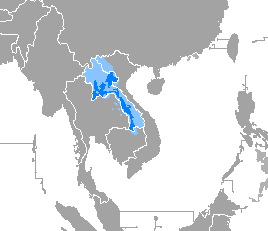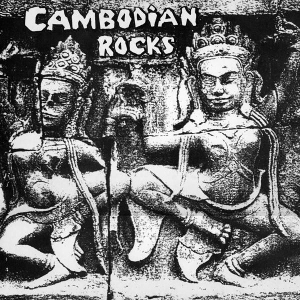
Khmer is an Austroasiatic language spoken by the Khmer people, and the official and national language of Cambodia. Khmer has been influenced considerably by Sanskrit and Pali, especially in the royal and religious registers, through Hinduism and Buddhism. It is also the earliest recorded and earliest written language of the Mon–Khmer family, predating Mon and Vietnamese, due to Old Khmer being the language of the historical empires of Chenla, Angkor and, presumably, their earlier predecessor state, Funan.

Lao, sometimes referred to as Laotian, is a Kra–Dai language of the Lao people. It is spoken in Laos, where it is the official language for around 7 million people, as well as in northeast Thailand, where it is used by around 23 million people, usually referred to as Isan. Lao serves as a lingua franca among the citizens of Laos, who also speak approximately 90 other languages, many of which are unrelated to Lao.

The Chams or Champa people are an Austronesian ethnic group. From the 2nd to the mid-15th century the Chams populated Champa, a contiguous territory of independent principalities in central and southern Vietnam. They spoke the Cham language and the Tsat language, two Chamic languages from the Malayo-Polynesian group of the Austronesian family. Chams and Malays are the only sizable Austronesian peoples that settled in Iron Age mainland Southeast Asia among the more ancient Austroasiatic inhabitants.

Champa was a collection of independent Cham polities that extended across the coast of what is today central and southern Vietnam from approximately the 2nd century AD until 1832, when it was annexed by the Vietnamese Empire under Minh Mạng. The kingdom was known variously as Nagaracampa, ꨌꩌꨛꨩ in the Chamic and Châmpa (ចាម្ប៉ា) in the Khmer inscriptions, Chiêm Thành in Sino-Vietnamese vocabulary and Zhànchéng in Chinese records. According to National Geographic, Champa's navy was considered unrivaled.

The music of Cambodia is derived from a mesh of cultural traditions dating back to the ancient Khmer Empire, India, China and the original indigenous tribes living in the area before the arrival of Indian and Chinese travelers. With the rapid Westernization of popular music, Cambodian music has incorporated elements from music around the world through globalization.
The Khmer script is an abugida (alphasyllabary) script used to write the Khmer language, the official language of Cambodia. It is also used to write Pali in the Buddhist liturgy of Cambodia and Thailand.

Sinn Sisamouth was a Cambodian singer-songwriter active from the 1950s to the 1970s.

Throughout Cambodia's long history, religion has been a major source of cultural inspiration. Over nearly three millennia, Cambodians have developed a unique Cambodian culture and belief system from the syncreticism of indigenous animistic beliefs and the Indian religions of Buddhism and Hinduism. Indian culture and civilization, including its languages and arts reached mainland Southeast Asia around the 1st century AD.

The Cham script is a Brahmic abugida used to write Cham, an Austronesian language spoken by some 245,000 Chams in Vietnam and Cambodia. It is written horizontally left to right, just like other Brahmic abugidas.
Jarai people or Jarais are an ethnic group in Vietnam's Central Highlands, as well as in the Cambodian northeast Province of Ratanakiri. During the Vietnam War, many Jarai persons, as well as members of other Montagnard groups, worked with US Special Forces, and many were resettled with their families in the United States, particularly in North Carolina, after the war.

The largest of the ethnic groups in Cambodia are the Khmer, who comprise approximately 90% of the total population and primarily inhabit the lowland Mekong subregion and the central plains. The Khmer historically have lived near the lower Mekong River in a contiguous arc that runs from the southern Khorat Plateau where modern-day Thailand, Laos and Cambodia meet in the northeast, stretching southwest through the lands surrounding Tonle Sap lake to the Cardamom Mountains, then continues back southeast to the mouth of the Mekong River in southeastern Vietnam.
Jarai is a Malayo-Polynesian language spoken by the Jarai people of Vietnam and Cambodia. The speakers of Jarai number approximately 262,800, not including other possible Jarai communities in countries other than Vietnam and Cambodia such as United States of America. They are the largest of the upland ethnic groups of Vietnam's Central Highlands known as Degar or Montagnards, and 25 per cent of the population in the Cambodian province of Ratanakiri.

Nam tiến was the Vietnamese expansionist policy for the southward expansion of the territory of Vietnam from the 11th century to the mid-19th century. The Vietnamese domain was gradually expanded from its original heartland in the Red River Delta into southern territories, controlled by the Champa kingdoms. In a span of some 700 years, Vietnam tripled the area of its territory and more-or-less acquired its elongated shape of today.

The city now known as Ho Chi Minh City has gone by several different names during its history, reflecting settlement by different ethnic, cultural and political groups. Originally known as Prey Nôkôr while a part of the Khmer Empire, it came to be dubbed Sài Gòn informally by Vietnamese settlers fleeing the Trịnh–Nguyễn War to the north. In time, control of the city and the area passed to the Vietnamese, who gave the city the name of Gia Định. This name remained until the time of French conquest in the 1860s, when the occupying force adopted the name Saïgon for the city, a westernized form of the traditional Vietnamese name. The current name was given after the Fall of Saigon in 1975, and honors Hồ Chí Minh, the first leader of North Vietnam. Even today, however, the informal name of Sài Gòn remains in daily speech both domestically and internationally, especially among the Vietnamese diaspora and local southern Vietnamese.

The Khmer Loeu is the collective name given to the various indigenous ethnic groups residing in the highlands of Cambodia. The Khmer Loeu are found mainly in the northeastern provinces of Ratanakiri, Stung Treng, and Mondulkiri. Most of the highland groups are Mon-Khmer peoples and are distantly related, to one degree or another, to the Khmer. Two of the Khmer Loeu groups are Chamic peoples, a branch of the Austronesian peoples, and have a very different linguistic and cultural background. The Mon–Khmer-speaking tribes are the aboriginal inhabitants of mainland Southeast Asia, their ancestors having trickled into the area from the northwest during the prehistoric metal ages. The Austronesian-speaking groups, Rade and Jarai, are descendants of the Malayo-Polynesian peoples who came to what is now coastal Vietnam, saw the rise and fall of their Champa kingdoms, and then migrated west over the Annamite Range, dispersing between the Mon–Khmer groups.

The Cambodian genocide was the systematic persecution and killing of Cambodians by the Khmer Rouge under the leadership of Communist Party of Kampuchea general secretary Pol Pot, who radically pushed Cambodia towards an entirely self-sufficient agrarian socialist society. It resulted in the deaths of 1.5 to 2 million people from 1975 to 1979, nearly a quarter of Cambodia's 1975 population.

Cambodian Rocks is a compilation of 22 uncredited, untitled Cambodian psychedelic and garage rock songs from the late 1960s and early 1970s. When the tracks were recorded, musicians in the thriving music scene were combining Western rock and pop genres with their own styles and techniques. When the Khmer Rouge came to power in 1975, artists were among those viewed as a threat to the regime's agrarian socialist vision, and several of the performers on the album are believed to have been among those killed during the ensuing Cambodian genocide of 1975–1979. A great deal of information about them and their creative output was lost, although some has been recovered since the album's release.
The United Front for the Liberation of Oppressed Races waged a nearly three decade long insurgency against the governments of North and South Vietnam, and later the unified Socialist Republic of Vietnam. The FULRO insurgents represented the interests of minority Muslim and Hindu Cham, Christian Montagnards, and Buddhist Khmer Krom against the ethnic Kinh Vietnamese. They were supported and equipped by China and Cambodia according to those countries' interests in the Indochina Wars.
Cambodian rock of the 1960s and 1970s was a thriving and prolific music scene based in Phnom Penh, Cambodia, in which musicians created a unique sound by combining traditional Cambodian music forms with rock and pop influences from records imported into the country from Latin America, Europe, and the United States. U.S. armed forces radio that had been broadcast to troops stationed nearby during the Vietnam War was also a primary influence. This music scene was abruptly crushed by the Khmer Rouge communists in 1975, and many of its musicians disappeared or were executed during the ensuing Cambodian genocide. Due to its unique sounds and the tragic fate of many of its performers, the Cambodian rock scene has attracted the interest of music historians and record collectors, and the genre gained new popularity upon the international release of numerous compilation albums starting in the late 1990s.
Vietnamization or Vietnamisation is the acquisition or imposition of elements of Vietnamese culture, in particular the Vietnamese language and customs. This was experienced in some historic periods by the non-Vietnamese populations of territories controlled or substantially under the influence of Vietnam. As with other examples of cultural assimilation, it could either be voluntary or forced and is most visible in the case of territories where the Vietnamese language or culture were dominant or where their adoption could result in increased prestige or social status, as was the case of the nobility of Champa, or other minorities like Tai, Chinese and Khmers. To a certain extent Vietnamization was also administratively promoted by the authorities regardless of eras.













